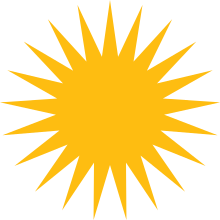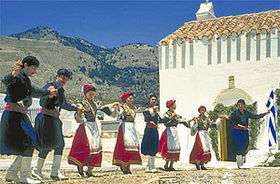Kurdish dance
Kurdish dance (Kurdish: Govend, Helperkê, Shayî; ھەڵپەڕکێ, شایی) is a group of traditional hand-holding dances similar to those from the Middle Eastern countries. It is a form of a circle dance, with a single or a couple of figure dancers often added to the geometrical center of the dancing circle. According to the Encyclopedia of Islam, Kurds sing and dance in all of their festivals, birthdays, New Years, Newroz, marriage and other ceremonies. Its noteworthy that these folkloric dances are mixed-gender which distinguishes the Kurds from other neighboring Muslim populations.[1]
 |
|
|
Modern history
|
Roots of Kurdish dance
Kurdish dances reflect samples of Kurdish life over the past thousands of years. Rhythmic and elegant movements (originating from historical record, geographical location, the Kurdish way of living, beliefs, work and struggle, war and quarrel), are called Halparke (or Helperkê/Hilperkê in Kurdish alphabet). Halparke has got its special place in Kurd's culture in a way that knowing about that needs the deep and valid slight of the viewers to watch the dancers' singing and giving thanks in Hoshar fighting against cruelty in Zangi joy and happiness in Garyan, etc..

The dancers, hand in hand, are depositories of centuries of revealed culture in Halparke that indicates their unity in history. These movements differ in different parts of Kurdistan from the variety point of views, and joy and worry have their own special place. Some kinds of these rhythms wear out and are forgotten through the passage of time. Kurdish people from Kurdistan mainly dance the helperke; it is easier and the simplest.
Kurdish dance is the one of the main cultural activity for most of the Kurdish women who can enjoy the day.[2]
Variations
In every dance one dancer falls or comes to the head of the circle who is called 'Serchopí', holding a colorful or symbolic object in his/her right hand. It is a tradition that no one take his/her place until he/she leads the dancers group at least one circle. The rest of dancers are called Gawaní. Sometimes Gawaní is also primarily called to the last dancer of the circle. This line of dancers differ from many ages.
Some Kurdish dances have various and numerous versions such as following:
- Dilan
- Sepe
- Chapi
The Geryan version is a fast motive dance. In the Dilan version, the dancers on the circular path consist, usually, of alternating men and women holding hands and colourful handkerchiefs called desroke, in a semicircle, and moving around the circle with the leading and trailing persons waving their kerchiefs in elaborate motions. The leading individual often accentuates the customary steps and motions for the dance by displaying more energy or even by adding to the standard moves some of his own personal liking. Chapi comes from the word "chep" or "chap" meaning "left". It is one of the more simple Kurdish dances. It consists of stepping forward on the left foot twice and then stepping back on the right foot twice while traveling in a circle. Sepe is similar to chepi but with motion towards the center of the circle and hitting the right foot roughly to the ground. There are also other variations used by Kurds, each dialect has its own form. Depending on location, some dialects have even the same dances, but in different directions.
References
- Kurds, Kurdistan, Part 4. "Dances and music", The Encyclopedia of Islam, Edited by C.E. Bosworth, E. van Donzel, B. Lewis & Ch. Pellat, Vol. V, KHE-MAHI, Leiden, E.J. BRILL Publishers, 1986, 1263 pp. (see p. 477).
- "Learn About Kurdish Dance | The Kurdish Project". The Kurdish Project.
See also
- Kurdish culture
- An Dro (Breton circle dance)
- Armenian dance
- Assyrian folk dance
- Dabke (a form of Arabic dance)
- Faroese dance
- Hora (Eastern European)
- Kolo (Serbian)
- Syrtos (Greek)
- Turkish dance
